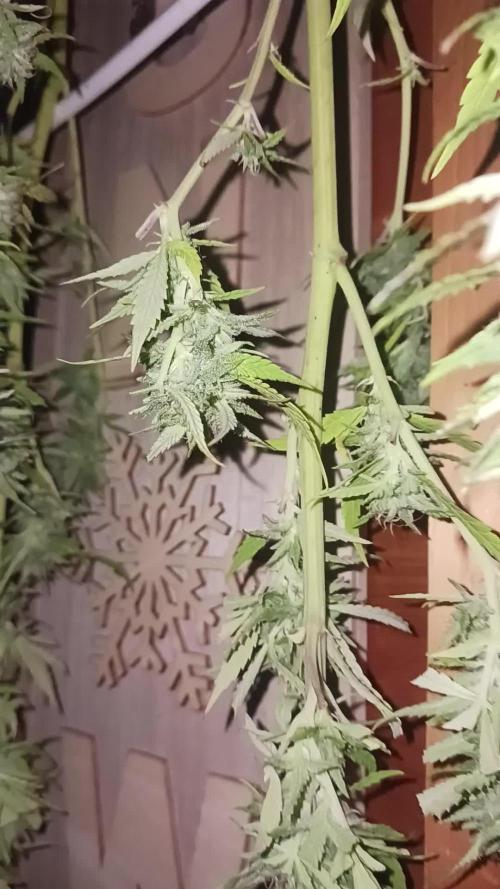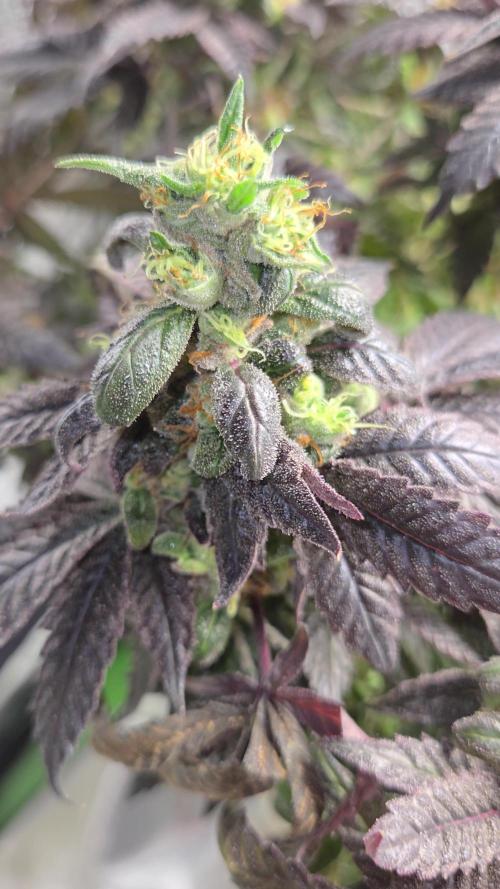The Grow Awards 2026 🏆 





























Likes
Comments
Share


@eldruidamx
Follow
Day 92. Watering with fertilizers.
Day 93. Watering with clean water.
Day 94. Watering with fertilizers.
Day 95. Watering with clean water.
Day 96. Watering with fertilizers.
Day 97. Watering with clean water.
Day 98. Watering with fertilizers.
Likes
3
Share


@DrewZenRox
Follow
3 Auto's set away.
Green Poison, Jealousy and Skywalker OG
Not a lot to report on as such.
14 days old.
Epic Attic 1.2 x 1.2 x 1.6 with 'Karma EVO 3'
https://ledgrowstore.co.uk/products/karma-horticulture-240w-evo-3-0umol
Ask for James, Top Bloke.
60x60x120 with Karma Stealth 1000
Strains purchased from 'The Vault' Seedbank.
https://www.cannabis-seeds-store.co.uk/
Ask for George, Top Man.
Pots/Trays/Substrate/Nutrients purchased from 'PeterleeHydroponics'
Ask for Neil, he's a Legend!
Likes
67
Share


@Dunk_Junk
Follow
Only a few days till I start staggered harvest. Whatever buds look ready I will cut off her.
Short video this week, sorry guys, technical problems 😑
Likes
158
Share


@love_2_grow
Follow
D64.
We're at the start of the fifth week of flower, and today, the Purplematic moved out, and now the Gorilla girl is all alone in the tent.
I also switched out her light from the big Kingbrite to the much smaller Viparspectra P600. I need the bigger light in my other tent, and even though the Viparspectra is a low-power light, I believe it should be enough, considering how small the Gorilla girl is. I could have put in one of the Greenception lights from my other tent, but it honestly was too much of a bother.
------------------------------
D66.
Yesterday, I gave her 2.5 liters of water @ pH 6.5 with humic acid and calmag.
Today, the green lacewing larvae (Chrysoperla Carnea) for combatting the thrips in my photo tent arrived, and I also dispersed a few of them in this tent. I haven't seen any thrips damage on the Gorilla girl, but I figured it wouldn't hurt to be proactive.
I also did minor defoliation to increase light penetration and air circulation.
------------------------------
D68.
Not much to report besides that this is one STINKY girl. She stinks up the entire lungroom, and I have ordered a new carbon filter.
Her senescence is slowly increasing, and I suspect she will be done soon-ish, although I haven't even looked at her trichomes yet.
------------------------------
D70.
We're at the end of the fifth week of flower, and chop day is getting close.
Her senescence is progressing nicely, and today, I checked her trichomes for the first time and already found quite a few amber ones.
She is coming down in a few days, but it won't be a large harvest due to her stunting. However, she smells fantastic, so I'm counting on a great smoke.
I went to WAR today against the spider mites we have in our ornamental plants in the apartment. I sprayed all plants with my homemade pesticide (capsaicin, alcohol, horticultural soap.) since I had it at hand. If that fails to knock the spider mites back, I'll bring out the neem oil instead.
The infestations aren't bad (yet), but it would suck to get mites into my tents, so better to be proactive.
------------------------------
Likes
25
Share


@rockbo47
Follow
SUMMARY: I flushed her this week on day 92 and thats it for nutes now until harvest on Saturday 10th April. I gave her a little flush on day 87 as she wasn't draining right and was still slowly dying. The runoff pH was 1 point up from the input though I'm not sure I trust the meter readings as my pen is cheap. Either way its in range and harvest is in sight so I'm not fucking around with her now.
I am making an effort to feed her 3 times per day now though some days I'm only managing 2 waterings. I read that the more frequently you water the better as each time you water it brings in fresh oxygen to the root zone. Therefore, the more frequently you water, the higher your yield will be. I should have been watering as often as possible throughout really but life and work commitments have restricted it to once-twice per day some days.
DAY 87
-----------
Tuesday 23rd March 11:00
I flushed the Amnesia with 1.5L of tap water though I didn't check the pH as the tap water is always 6.2-6.4 which is fine. However after flushing I tested the water before and after going through the medium and according to my pH pen the tap water was reading at 5.1 which simply can't be right but multiple tests showed 5.1. The runoff pH after flush was somehow coming out to 6.1 which just doesn't make ANY sense at all to me. But it's in range and too late in the game to fuck about anymore.
[26°C/46%]
I made 15L of late bloom nutes with molasses and rainwater. 5L at 5.7, 5L at 5.8, and 5L at 6.0.
DAY 88
-----------
Wednesday 24th March 11:00
I fed the Amnesia 300ml of late bloom nutes which produced 140ml runoff (47%).
Wednesday 24th March 18:30
I fed the Amnesia 200ml of late bloom nutes which produced 200ml runoff (100%). [26°C/48%]
DAY 89
-----------
Thursday 25th March 09:30
I fed the Amnesia 300ml of late bloom nutes which produced 50ml runoff (17%). Shes draining so much quicker now that I do think there was a build up prior to flushing...and she does seem to be drinking more now...I don't know . [26°C/46%]
I made 15L of late bloom nutes with molasses and rainwater. 5L at 5.7, 5L at 5.8, and 5L at 6.0.
Thursday 25th March 18:30
I fed the Amnesia a further 100ml of late bloom nutes which produced 80ml runoff (45%). [26°C/48%]
Thursday 25th March 20:30
I fed the Amnesia a further 200ml of late bloom nutes which produced 160ml runoff (80%). [26°C/48%]
DAY 90
-----------
Friday 26th March 09:30
I fed the Amnesia 300ml of late bloom nutes which produced 110ml runoff (37%). [26°C/46%]
Friday 26th March 14:30
I fed the Amnesia 200ml of late bloom nutes which produced 110ml runoff (55%). [26°C/46%]
Friday 26th March 18:30
I fed the Amnesia a further 100ml of late bloom nutes which produced 90ml runoff (90%). [26°C/48%]
Friday 26th March 20:30
I fed the Amnesia a further 200ml of late bloom nutes which produced 160ml runoff (80%). [26°C/48%]
DAY 91
--------
Saturday 27th March 09:30
I fed the Amnesia 300ml of late bloom nutes which produced 110ml runoff (37%). [26°C/46%]
Saturday 27th March 14:30
I fed the Amnesia 200ml of late bloom nutes which produced 110ml runoff (55%). [26°C/46%]
Saturday 27th March 18:30
I fed the Amnesia a further 100ml of late bloom nutes which produced 90ml runoff (90%). [26°C/48%]
Saturday 27th March 20:30
I fed the Amnesia a further 200ml of late bloom nutes which produced 160ml runoff (80%). [26°C/48%]
DAY 92
--------
Sunday 28th March
I flushed her with tap water straight from the hose. I’ve heard you’re supposed to flush with 3x the container volume and so I flushed her with more than that to be sure. Moving forward I will be watering her 2-3 times per day with pH'd tap or rain water providing 20-30% runoff each feeding.
Likes
13
Share


@ChitownCannaChica
Follow
Have been flushing the past 2 weeks hence the yellow and purple leaves. Chopping her down right after this photo shoot. Probably get 14-20 grams dry, but not bad for a solo cup auto with pretty quality buds. Stem has been green the whole time— so she’s healthy. The smell is an earthy pine cone. Easy peezy with dynomyco!
✌️💚🌿💨
Likes
4
Share


@Thekongie
Follow
Lots of rain here in the past week had to cover the crops ! These girls seems to getting fatty. I’m not really sure when to harvest.
Likes
21
Share


@MadeInGermany
Follow
Hey guys :-)
First of all I have to say that all 5 strains I have in the tent from Amsterdam Genetic are beautiful genetics 👍 .
This week they were repotted into 8L fabric pots.
When repotting, 2 g of Green House Powder Feeding Bio line were added per liter of substrate :-) .
That's enough until the first flowers start 👍.
Watering was done twice this week with 0.8 l each.
Otherwise everything was cleaned and checked and fresh osmosis water was mixed.
Stay healthy 🙏🏻💚
👇🏼👇🏼👇🏼👇🏼👇🏼👇🏼👇🏼👇🏼👇🏼👇🏼👇🏼👇🏼
You can buy this Nutrients at :
https://shop.greenhousefeeding.com/us/
👇🏼👇🏼👇🏼👇🏼👇🏼👇🏼👇🏼👇🏼👇🏼👇🏼👇🏼👇🏼
You can buy this strain at :
https://www.amsterdamgenetics.com/product/double-blue/
Water 💧 💧💧
Osmosis water mixed with normal water (24 hours stale that the chlorine evaporates) to 0.2 EC. Add Cal / Mag to 0.4 Ec Ph with Organic Ph - to 5.8 - 6.4
MadeInGermany
Likes
6
Share


@Chubbs
Follow
FBA2507-week 1 of Veg
This week has been wild. Once the roots made a foundation the upper growth has been explosive the last few days. Really cool to watch and see the daily growth. I introduce calmag and grow nutrients this week starting at a 1/4 strength. All in all they've responded well showing no burn what so ever. Happy Growing
Likes
48
Share


@MadeInGermany
Follow
Info:
Unfortunately, I had to find out that my account is used for fake pages in social media.
I am only active here on growdiaries.
I am not on facebook instagram twitter etc All accounts except this one are fake.
Have fun with the update.
Flowering day 21
since time change
to 12/12 h.
Hi everyone :-) .
This week she has made great progress.
Your growth becomes more extreme every week 😅.
Yesterday the complete water was changed and switched from vegi to flower fertilizer.
Despite all the tying down with the net, the lady proliferates everywhere :-).
Unfortunately, it is already growing very high above the net, so the next time I will make it even less vegi :-).
In the coming days everything will be cleaned under the net.
Otherwise everything was cleaned and refilled.
Stay healthy 🙏🏻.
You can buy this Strain at
https://www.amsterdamgenetics.com/product/kosher-tangie-kush/
Type:
Kosher Tangie Kush
☝️🏼
Genetics:
Kosher Kush
X
Tangie
👍
Vega lamp: 2 x Todogrow LED CXB3590 COB 55 W
1 x Sanlight S2W 62 W
💡
Flower lamp : 2 x Todogrow LED CXB3590 COB 55 W
1 x Sanlight S2W 62 W
💡 ☝️
Grow Aero System : Growtool 0.8
☝️
Fertilizer:
Canna Aqua Vega A + B , Canna Aqua Flores A + B , Rizotonic, Cannazym, CANNA Boost, Pk 13/14, Canna Cal / Mag, Canna Ph - Grow, Canna Ph-Bloom
☝️🌱
Water:
Osmosis water mixed with normal water (24 hours stale that the chlorine evaporates) to 0.2 EG. Add Cal / Mag to 0.4 Ec Ph with ph- to 5.2 - 5.8
💦 💧
Likes
12
Share


@VeeDro203
Follow
This was an easy grow! Everything is in day 11 of dry as of this post! Ready for trim jail!
Likes
85
Share


@Grey_Wolf
Follow
Happy New Everyone 😀 🙏🙏
I have now got all of my Photoperiod Girls under a Greenhouse. Its only an elcheapo from Ebay but I reinforced it with a heap of good old Gaffer tape and Zipties.
I also ran guide ropes to the ground at the corners for Protection against heavy winds so hopefully it'll stay put.
The Wifi Plant just keeps growing and growing and will soon need some type of branch support and I'm thinking of using some of those plant yo yo's.
The white residue you can see on the leaves is Diatomaceous earth. I mixed some into the worm/mollasses tea just before I sprayed my plants with it.
It acts as a bug deterrent and can't hurt the plant in any way. I also mix some into the worm tea that I feed straight to the soil as Diatomaceous Earth is a fantastic source of Silica which we all know is extremely beneficial to your Plants Health.
As Far as my super soil is concerned , so far I have not needed to feed the plants any fertilisers as the soil is providing everything the plant needs.
All ive been adding is biodynamic food for the soil itself to keep everything under the surface happy and well nourished.
Once flowering begins next month I will need to add an organic Booster to the soil that will replace any depleted resources.
Because I only feed water throughout the grow there is no need for any final flush I can simply Harvest when it's ready and dry/cure etc.
Thankyou for reading this weeks update 2nd January 2020 👍
Likes
17
Share


@masterofsmeagol
Follow
9/13 Took the last special Kush today. I had too. Those fucking locusts were eating more and more. At least the trichs looked good. The second plant is straight fire! They're ALL good. I'll have to do the review. Tenth planet is swelling up and trichs are getting cloudier. They are starting to eat the chem dog too but it needs to bulk up and the trichs aren't there yet. Mk ultra natural may be some of the best quality this year. I'm losing SOME to tje locusts but it seems they avoid the frostier stuff. At least I'm hoping. This is a great plantvand despite the nugs being so tight and stuff it just needs more time and im going to give it to her. Pink kush is actually look9ng like it might finish. But the locusts have STRIPPED a lot of that. I'll keep an eye on them and keep this uodated.
Likes
11
Share


@CityFarmer
Follow
Hello everyone,
Been busy but I shoot a little video for yall to see, also if growing is something you guys intended to do, I suggest you guys get yourselves a Digital Microscope or a jewlers loop.
I just got myself a Digital Microscope for under $20.00 on Walmart.com, I got me a cheap one to start with so I can learn how to use it properly. But for under $20.00 this one brings 8 led lights, a adjustable mount, comes with 3 different connection choices build in, magnifies from 50-1000x, can take pictures and also videos and my favorite part, it connects right to my mobile device, you download and install a Google app and your ready to go, ill work with it and add pictures next week...
See you guys soon 👊👊👊
Likes
4
Share


@sunnykuyall
Follow
04 - 07 May 2023 - Germination Week
08 - 14 May 2023 - Veg week 1
15 - 21 May 2023 - Veg week 2
22 - 28 May 2023 - Veg week 3
29 - 04 June 2023 - Veg week 4
05 - 11 June 2023 - Veg week 5
12 - 18 June 2023 - Flower weel 1






























